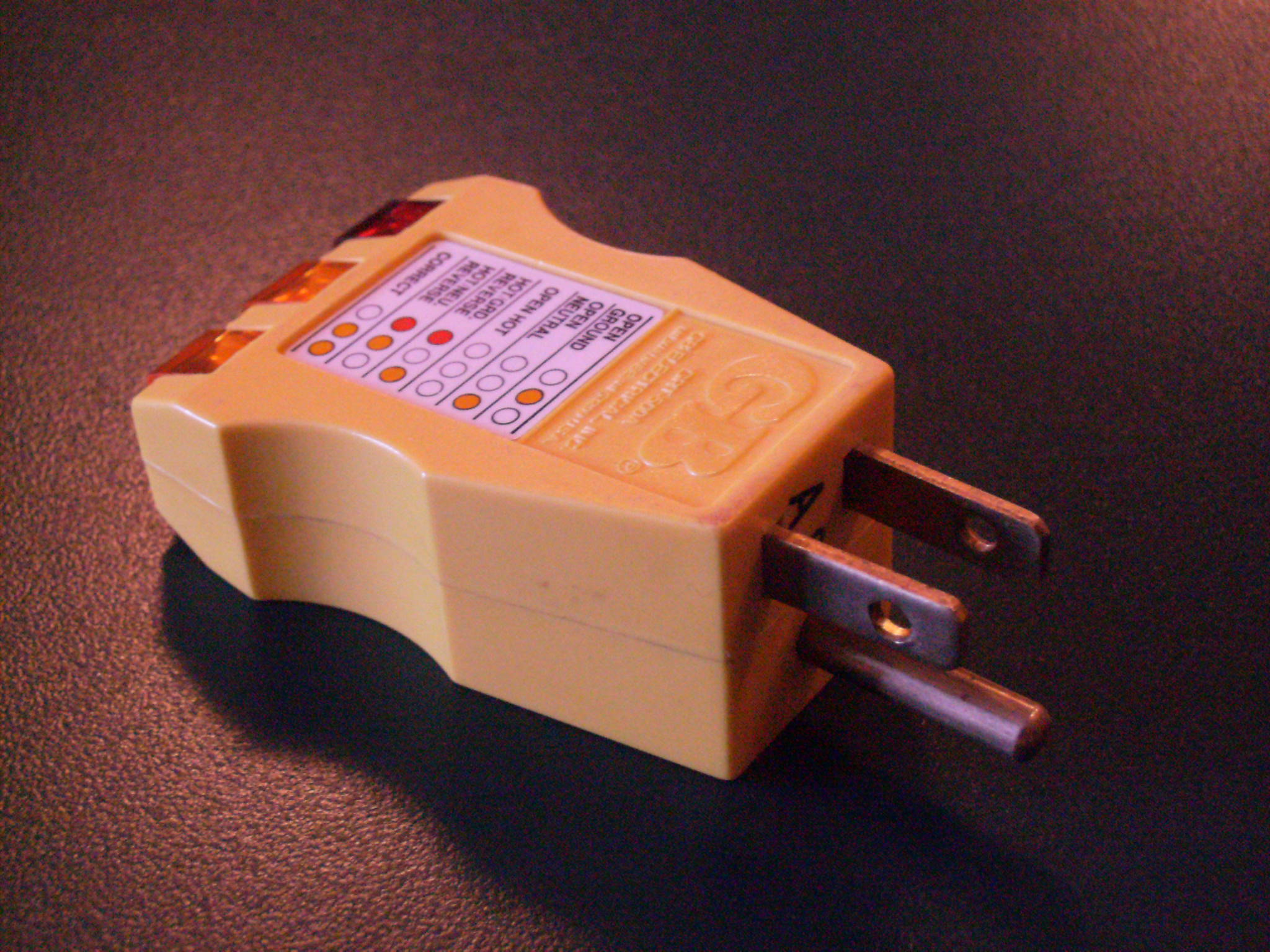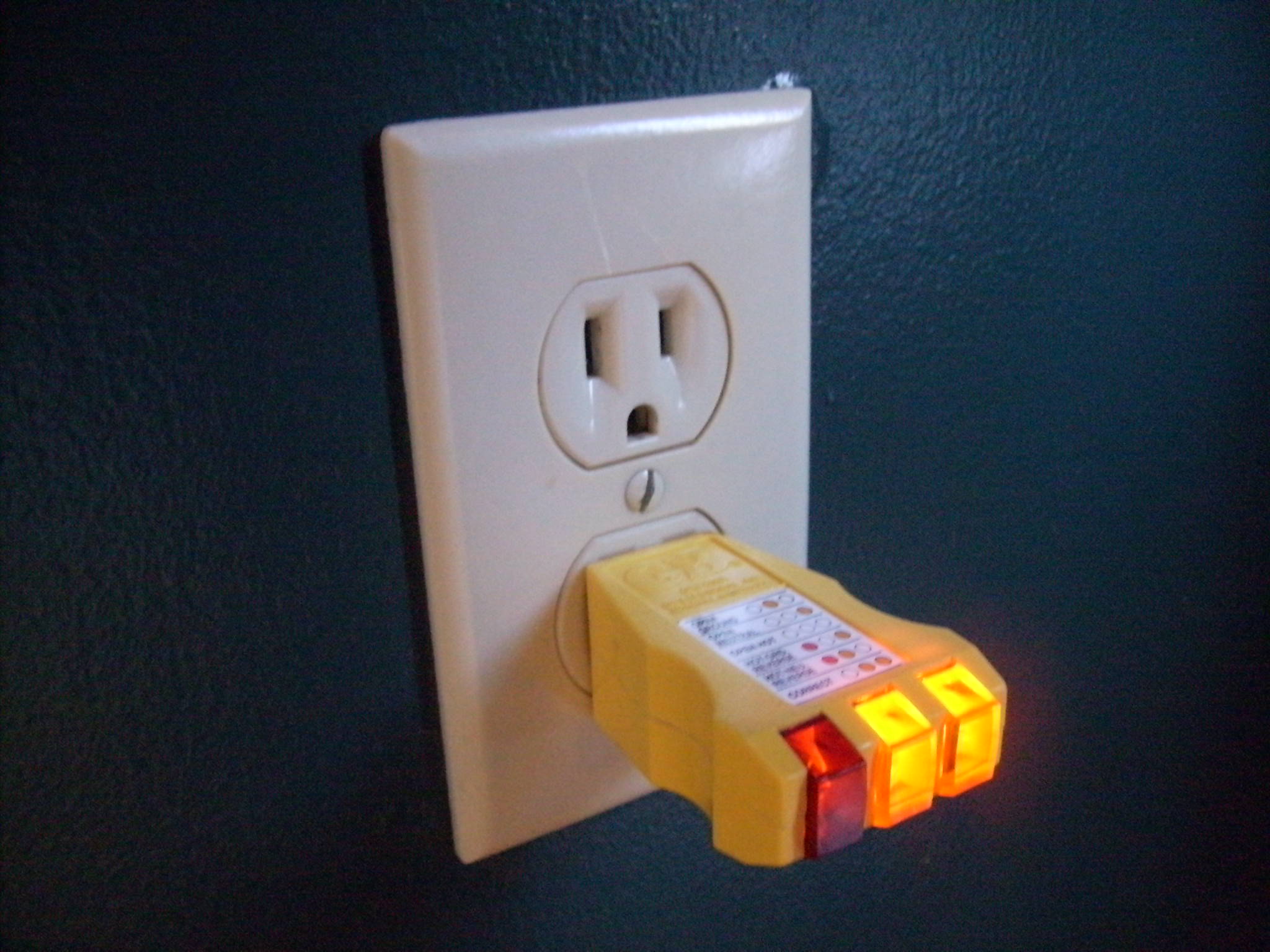Receptacle Tester on:
[Wikipedia]
[Google]
[Amazon]
 An electrical outlet tester, receptacle tester, or socket tester is a small device containing a 3-prong power plug and three indicator lights, used for quickly detecting some types of incorrectly-wired electrical wall outlets or campsite supplies. The tester is easily carried in a pocket, can be used with little training, and can identify some common wiring problems, but it fails to detect certain other dangerous types of wiring defects.
An electrical outlet tester, receptacle tester, or socket tester is a small device containing a 3-prong power plug and three indicator lights, used for quickly detecting some types of incorrectly-wired electrical wall outlets or campsite supplies. The tester is easily carried in a pocket, can be used with little training, and can identify some common wiring problems, but it fails to detect certain other dangerous types of wiring defects.
 The outlet tester checks that each contact in the outlet appears to be connected to the correct wire in the building's electrical wiring. It can identify several common wiring errors, including swapped phase and neutral, and failure to connect ground.
The tester confirms continuity and polarity of the electrical connections, but it does not verify current-carrying ability, electrical safety (which requires impedance testing), insulation breakdown voltage, or loop connection of ring mains.
Simple three-light testers cannot detect some potentially serious house wiring errors, including neutral and ground interchanged at the receptacle. There may be a " bootleg ground", where the neutral and ground pins have been connected together at the receptacle, which cannot be detected either. These problems can be detected with a multimeter and a test load, to verify that the ground connection is separate from the neutral and is not carrying normal circuit return current, or more typically by using a more-sophisticated
The outlet tester checks that each contact in the outlet appears to be connected to the correct wire in the building's electrical wiring. It can identify several common wiring errors, including swapped phase and neutral, and failure to connect ground.
The tester confirms continuity and polarity of the electrical connections, but it does not verify current-carrying ability, electrical safety (which requires impedance testing), insulation breakdown voltage, or loop connection of ring mains.
Simple three-light testers cannot detect some potentially serious house wiring errors, including neutral and ground interchanged at the receptacle. There may be a " bootleg ground", where the neutral and ground pins have been connected together at the receptacle, which cannot be detected either. These problems can be detected with a multimeter and a test load, to verify that the ground connection is separate from the neutral and is not carrying normal circuit return current, or more typically by using a more-sophisticated
Ways a receptacle tester can mislead
(by an electrician)
Diagnosing Power Problems at the Receptacle
Duane Smith, EC&M, October 1, 2004 Electronic test equipment Electrical wiring
 An electrical outlet tester, receptacle tester, or socket tester is a small device containing a 3-prong power plug and three indicator lights, used for quickly detecting some types of incorrectly-wired electrical wall outlets or campsite supplies. The tester is easily carried in a pocket, can be used with little training, and can identify some common wiring problems, but it fails to detect certain other dangerous types of wiring defects.
An electrical outlet tester, receptacle tester, or socket tester is a small device containing a 3-prong power plug and three indicator lights, used for quickly detecting some types of incorrectly-wired electrical wall outlets or campsite supplies. The tester is easily carried in a pocket, can be used with little training, and can identify some common wiring problems, but it fails to detect certain other dangerous types of wiring defects.
Tests and limitations
 The outlet tester checks that each contact in the outlet appears to be connected to the correct wire in the building's electrical wiring. It can identify several common wiring errors, including swapped phase and neutral, and failure to connect ground.
The tester confirms continuity and polarity of the electrical connections, but it does not verify current-carrying ability, electrical safety (which requires impedance testing), insulation breakdown voltage, or loop connection of ring mains.
Simple three-light testers cannot detect some potentially serious house wiring errors, including neutral and ground interchanged at the receptacle. There may be a " bootleg ground", where the neutral and ground pins have been connected together at the receptacle, which cannot be detected either. These problems can be detected with a multimeter and a test load, to verify that the ground connection is separate from the neutral and is not carrying normal circuit return current, or more typically by using a more-sophisticated
The outlet tester checks that each contact in the outlet appears to be connected to the correct wire in the building's electrical wiring. It can identify several common wiring errors, including swapped phase and neutral, and failure to connect ground.
The tester confirms continuity and polarity of the electrical connections, but it does not verify current-carrying ability, electrical safety (which requires impedance testing), insulation breakdown voltage, or loop connection of ring mains.
Simple three-light testers cannot detect some potentially serious house wiring errors, including neutral and ground interchanged at the receptacle. There may be a " bootleg ground", where the neutral and ground pins have been connected together at the receptacle, which cannot be detected either. These problems can be detected with a multimeter and a test load, to verify that the ground connection is separate from the neutral and is not carrying normal circuit return current, or more typically by using a more-sophisticated multifunction tester {{unref, date=April 2012
A multifunction tester or MFT is an electronic device used by electricians to test electrical circuits that use the "low voltage, low" and "extra-low voltages" typically used by consumers in domestic, commercial and agricul ...
.
A quick supplemental screening test for these simple miswiring errors can be performed using a non-contact voltage tester (NCVT) or non-contact voltage detector. If a problem is thus identified, it can be investigated further using more-advanced equipment, or the outlet in question can be de-energized and disassembled for careful scrutiny.
Some receptacle testers include an additional test button to test the triggering of GFCI devices, which supplements the built-in test button on the GFCI and can be used for testing outlets downstream from a GFCI receptacle. "Plug-in analyzers" may include earth loop impedance and other checks.
History
An early reference that describes the typical outlet tester circuit was published inPopular Mechanics
''Popular Mechanics'' (sometimes PM or PopMech) is a magazine of popular science and technology, featuring automotive, home, outdoor, electronics, science, do-it-yourself, and technology topics. Military topics, aviation and transportation o ...
in the March issue of 1967, and consists of two 27 kΩ resistors, one 100 kΩ resistor, and three NE-51 neon lamp
A neon lamp (also neon glow lamp) is a miniature gas discharge lamp. The lamp typically consists of a small glass capsule that contains a mixture of neon and other gases at a low pressure and two electrodes (an anode and a cathode). When suff ...
bulbs with 100 kΩ resistors.
See also
* Polarized plugs * Test lightReferences
{{commons category, Receptacle testersExternal links
Ways a receptacle tester can mislead
(by an electrician)
Diagnosing Power Problems at the Receptacle
Duane Smith, EC&M, October 1, 2004 Electronic test equipment Electrical wiring